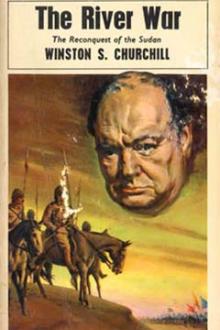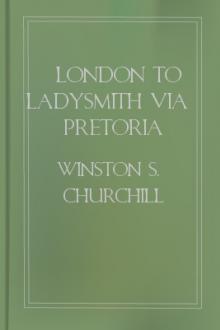The River War - Winston Churchill (books under 200 pages .txt) 📗

- Author: Winston Churchill
- Performer: -
Book online «The River War - Winston Churchill (books under 200 pages .txt) 📗». Author Winston Churchill
An insurmountable obstacle confronted them. Yet what could not be overcome might be avoided. The hardy Dervishes could endure privations which would destroy the soldiers of civilisation. Barren and inhospitable as was the desert, they might move round the army at the Atbara fort and so capture Berber after all. Once they were behind the Egyptians, these accursed ones were lost. The railway—that mysterious source of strength—could be cut. The host that drew its life along it must fight at a fearful disadvantage or perish miserably. Besides, he reminded Mahmud —not without reason—that they could count on help in Berber itself.
The agreement of the Emirs, called to the council, decided the Dervish leader. His confidence in himself was weakened, his hatred of Osman Digna increased. Nevertheless, following the older man’s advice, he left Aliab on the 18th of March, and struck northeast into the desert towards the village and ford of Hudi on the Atbara river.
Thence by a long desert march he might reach the Nile and Berber. But while his information of the Sirdar’s force and movements was uncertain, the British General was better served. What Mahmud failed to derive from spies and ‘friendlies,’ his adversary obtained by gunboats and cavalry.
As soon, therefore, as Sir H. Kitchener learned that the Dervishes had left the Nile and were making a detour around his left flank, he marched up the Atbara river to Hudi. This offered Mahmud the alternative of attacking him in a strong position or of making a still longer detour. Having determined upon caution he chose the latter, and, deflecting his march still more to the east, reached the Atbara at Nakheila. But from this point the distance to Berber was far too great for him to cover. He could not carry enough water in his skins. The wells were few, and held against him. Further advance was impossible. So he waited and entrenched himself, sorely troubled, but uncertain what to do. Supplies were running short.
His magazines at Shendi had been destroyed as soon as he had left the Nile.
The Dervishes might exist, but they did not thrive, on the nuts of the dom palms. Soldiers began to desert. Osman Digna, although his advice had been followed, was at open enmity. His army dwindled.
And all this time his terrible antagonist watched him as a tiger gloats on a helpless and certain prey—silent, merciless, inexorable. Then the end came suddenly. As soon as the process of attrition was sufficiently far advanced to demoralise the Dervish host, without completely dissolving them, the Sirdar and his army moved. The victim, as if petrified, was powerless to fly. The tiger crept forward two measured strides—
from Ras-el-Hudi to Abadar, from Abadar to Umdabia—crouched for a moment, and then bounded with irresistible fury upon its prey and tore it to pieces.
Such is a brief strategic account of the Atbara campaign; but the tale must be told in full.
On the 23rd of January the Khalifa, having learned of the arrival of British troops near Abu Hamed, and baffled by the disputes about the command of his army, ordered Kerreri camp to be broken up, and permitted his forces to return within the city, which he continued to fortify.
A few days later he authorised Mahmud to advance against Berber. What he had not dared with 60,000 men he now attempted with 20,000. The course of action which had for three months offered a good hope of success he resolved to pursue only when it led to ruin. He forbade the advance while it was advisable. When it was already become mad and fatal he commanded it.
And this was a man whose reputation for intelligence and military skill had been bloodily demonstrated!
The gunboats ceaselessly patrolled the river, and exchanged shots with the Dervish forts. Throughout January nothing of note had happened.
The reports of spies showed the Khalifa to be at Kerreri or in Omdurman.
Ahmed Fedil held the Shabluka Gorge, Osman Digna was at Shendi, and his presence was proved by the construction of two new forts on that side of the river. But beyond this the Dervishes had remained passive. On the 12th of February, however, it was noticed that their small outpost at Khulli had been withdrawn. This event seemed to point to a renewal of activity.
It was felt that some important movement impended. But it was not until the 15th that its nature was apparent, and the gunboats were able to report definitely that Mahmud was crossing to the east bank of the Nile.
The flotilla exerted itself to harass the Dervishes and impede the transportation; but although several sailing-boats and other river craft were captured, Mahmud succeeded in moving his whole army to Shendi by the 28th of February. His own headquarters were established at Hosh-ben-Naga, a little village about five miles further south. A delay of more than a fortnight followed, during which the gunboats exercised the utmost vigilance. The Suakin-Berber road was again closed for caravans, and the Sirdar himself proceeded to Berber. On the 11th of March the remnants of the Jaalin tribe, having collected at Gakdul, re-occupied the now abandoned Metemma, to find its streets and houses choked with the decaying bodies of their relations. On the 13th the Egyptian lookout station, which had been established on Shebaliya island, was attacked by the Dervishes, and in the skirmish that ensued Major Sitwell was wounded. On the same day the enemy were reported moving northwards to Aliab, and it became evident that Mahmud had begun his advance.
He started from Shendi with a force which has been estimated at 19,000 souls, but which included many women and children, and may have actually numbered 12,000 fighting men, each and all supplied with a month’s rations and about ninety rounds of ammunition. The Sirdar immediately ordered the Anglo-Egyptian army, with the exception of the cavalry and Lewis’s Egyptian brigade—which, with three squadrons, held the fort at the confluence—to concentrate at Kunur. Broadwood, with the remaining five squadrons, marched thither on the 16th; and the whole cavalry force, with the Camel Corps in support, on the three subsequent days reconnoitred twenty miles up the Nile and the Atbara.
Meanwhile the concentration was proceeding apace. The two Soudanese brigades, formed into a division under command of Major-General Hunter, with the artillery, reached Kunur on the night of the 15th. The British brigade—the Lincolns, the Warwicks, and the Camerons—marched thither from Dabeika. The Seaforth Highlanders, who on the 13th were still at Wady Halfa, were swiftly railed across the desert to Geneinetti. Thence the first half-battalion were brought to Kunur in steamers. The second wing—
since the need was urgent and the steamers few—were jolted across the desert from Railhead on camels, an experience for which neither their training nor their clothes had prepared them. By the 16th the whole force was concentrated at Kunur, and on the following day they were reviewed by the Sirdar. The first three days at Kunur were days of eager expectation.
Rumour was king. The Dervish army had crossed the Atbara at Hudi, and was within ten miles of the camp. Mahmud was already making a flank march through the desert to Berber. A battle was imminent. A collision must take place in a few hours. Officers with field-glasses scanned the sandy horizon for the first signs of the enemy. But the skyline remained unbroken, except by the wheeling dust devils, and gradually the excitement abated, and the British brigade began to regret all the useful articles they had scrupulously left behind them at Dabeika, when they marched in a hurry and the lightest possible order to Kunur.
On the 19th of March the gunboats reported that the Dervishes were leaving the Nile, and Mahmud’s flanking movement became apparent. The next day the whole force at Kunur marched across the desert angle between the rivers to Hudi. The appearance of the army would have been formidable. The cavalry, the Camel Corps, and the Horse Artillery covered the front and right flank; the infantry, with the British on the right, moved in line of brigade masses; the transport followed. All was, however, shrouded in a fearful dust-storm. The distance, ten miles, was accomplished in five hours, and the army reached Hudi in time to construct a strong zeriba before the night. Here they were joined from Atbara fort by Lewis’s brigade of Egyptians—with the exception of the 15th Battalion, which was left as garrison—and the troops at the Sirdar’s disposal were thus raised to 14,000 men of all arms. This force was organised as follows: Commander-in-Chief: THE SIRDAR
British Brigade: MAJOR-GENERAL GATACRE
1st Battalion Royal Warwickshire Regiment (6 companies) ” ” Lincolnshire Regiment
” ” Seaforth Highlanders
” ” Cameron Highlanders
Egyptian Infantry Division: MAJOR-GENERAL HUNTER
1st Brigade 2nd Brigade 3rd Brigade LIEUT.-COL. MAXWELL LIEUT.-COL. MACDONALD LIEUT.-COL. LEWIS
8th Egyptians 2nd Egyptians 3rd Egyptians XIIth Soudanese IXth Soudanese 4th “
XIIIth ” Xth ” 7th “
XIVth ” XIth “
Cavalry: LIEUT.-COL. BROADWOOD
8 squadrons
2 Maxim guns
Camel Corps: MAJOR TUDWAY
6 companies
Artillery: LIEUT.-COL. LONG
Detachment, No. 16 Company, E Division R.A., with 6 five-inch B.L. howitzers
Egyptian Horse Battery (6 guns)
Nos. 1, 2, and 3 Field Batteries Egyptian Army (18 guns) British Maxim Battery (4 guns)
Rocket Detachment (2 sections)
Mahmud had early intelligence of the movement of the Anglo-Egyptian army.
His original intention had been to march to Hudi. But he now learned that at Hudi he would have to fight the Sirdar’s main force. Not feeling strong enough to attack them, he determined to march to Nakheila. The mobility of the Arabs was now as conspicuous as their dilatory nature had formerly been. The whole Dervish army—horse, foot, and artillery, men, women, children, and animals—actually traversed in a single day the forty miles of waterless desert which lie between Aliab and Nakheila, at which latter place they arrived on the night of the 20th. The Sirdar’s next object was to keep the enemy so far up the Atbara that they could not possibly strike at Berber or Railhead. Accordingly, at dawn on the 21st, the whole force was ordered to march to Ras-el-Hudi, five miles nearer the Dervishes’
supposed halting-place. The detour which the Arabs would have to make to march round the troops was nearly doubled by this movement. The utter impossibility of their flank march with a stronger enemy on the radius of the circle was now apparent.
The movement of the Anglo-Egyptian force was screened by seven squadrons of cavalry and the Horse Artillery, and Colonel Broadwood was further instructed to reconnoitre along the river and endeavour to locate the enemy. The country on either bank of the Atbara is covered with dense scrub, impassable for civilised troops. From these belts, which average a quarter of a mile in depth, the dom palms rise in great numbers. All the bush is leafy, and looks very pretty and green by contrast with the sombre vegetation of the Nile. Between the trees fly gay parrots and many other bright birds. The river itself above Ras-el-Hudi is, during March and April, only a dry bed of white sand about 400 yards broad, but dotted with deep and beautifully clear pools, in which peculiarly brilliant fish and crocodiles, deprived of their stream, are crowded together. The atmosphere is more damp than by the Nile, and produces, in the terrible heat of the summer, profuse and exhausting perspiration. The natives dislike the water of the Atbara, and declare that it does not quench the thirst like that of the great





Comments (0)